Milwaukee M18 2601-22 Handleiding
Milwaukee
Boormachine
M18 2601-22
Bekijk gratis de handleiding van Milwaukee M18 2601-22 (11 pagina’s), behorend tot de categorie Boormachine. Deze gids werd als nuttig beoordeeld door 38 mensen en kreeg gemiddeld 4.9 sterren uit 19.5 reviews. Heb je een vraag over Milwaukee M18 2601-22 of wil je andere gebruikers van dit product iets vragen? Stel een vraag
Pagina 1/11

M18™
1/2" COMPACT DRIVER DRILL
PERCEUSE-VISSEUSE COMPACTE D’13 mm (1/2 PO) DE M18™
TALADRO DESTORNILLADOR COMPACTO DE 13 mm (½ PULG.) Y M18™
Cat. No.
No de Cat.
2601-20
OPERATOR'S MANUAL
MANUEL de L'UTILISATEUR
MANUAL del OPERADOR
TO REDUCE THE RISK OF INJURY, USER MUST READ AND UNDERSTAND OPERATOR'S
MANUAL.
AFIN DE RÉDUIRE LE RISQUE DE BLESSURES, L'UTILISATEUR DOIT LIRE ET BIEN
COMPRENDRE LE MANUEL DE L'UTILISATEUR.
PARA REDUCIR EL RIESGO DE LESIONES, EL USUARIO DEBE LEER Y ENTENDER EL
MANUAL DEL OPERADOR.

23
3
2
4
5
6
7
1
1. Keyless chuck
2. Torque selector collar
3. Speed selector
4. Trigger
5. Control switch
6. LED
7. Sleeve
FUNCTIONAL DESCRIPTION SYMBOLOGY
SPECIFICATIONS
ASSEMBLY
WARNING Recharge only with the
charger specifi ed for the battery. For specifi c
charging instructions, read the operator’s
manual supplied with your charger and battery.
Inserting/Removing the Battery
To remove the battery, push in the release buttons
and pull the battery pack away from the tool.
To insert the battery, slide the pack into the body of
the tool. Make sure it latches securely into place.
Cat. No. Volts
DC
No Load
RPM
Capacities
Steel Flat Bit Auger Bit Hole Saw Screws (dia.)
2601-20 18 Low 0 - 500
High 0 - 1 500
1/2"
1/2"
1-1/8"
1-1/8"
1"
N/A
2-1/8"
2-1/8"
1/4"
1/4"
Volts
Direct Current
No Load Revolutions per
Minute (RPM)
C US Underwriters Laboratories, Inc.
United States and Canada
PERSONAL SAFETY
GENERAL POWER TOOL SAFETY WARNINGS
WORK AREA SAFETY
ELECTRICAL SAFETY
• Keep work area clean and well lit. Cluttered or
dark areas invite accidents.
• Do not operate power tools in explosive atmos-
pheres, such as in the presence of fl ammable
liquids, gases or dust. Power tools create sparks
which may ignite the dust or fumes.
• Keep children and bystanders away while
operating a power tool. Distractions can cause
you to lose control.
• Power tool plugs must match the outlet. Never
modify the plug in any way. Do not use any
adapter plugs with earthed (grounded) power
tools. Unmodifi ed plugs and matching outlets will
reduce risk of electric shock.
• Avoid body contact with earthed or grounded
surfaces such as pipes, radiators, ranges and
refrigerators. There is an increased risk of electric
shock if your body is earthed or grounded.
• Do not expose power tools to rain or wet condi-
tions. Water entering a power tool will increase
the risk of electric shock.
• Do not abuse the cord. Never use the cord for
carrying, pulling or unplugging the power tool.
Keep cord away from heat, oil, sharp edges
or moving parts. Damaged or entangled cords
increase the risk of electric shock.
• When operating a power tool outdoors, use an
extension cord suitable for outdoor use. Use
of a cord suitable for outdoor use reduces the risk
of electric shock.
• If operating a power tool in a damp location is
unavoidable, use a ground fault circuit inter-
rupter (GFCI) protected supply. Use of an GFCI
reduces the risk of electric shock.
• Remove any adjusting key or wrench before
turning the power tool on. A wrench or a key left
attached to a rotating part of the power tool may
result in personal injury.
• Do not overreach. Keep proper footing and
balance at all times. This enables better control
of the power tool in unexpected situations.
• Dress properly. Do not wear loose clothing or
jewellery. Keep your hair, clothing and gloves
away from moving parts. Loose clothes, jewel-
lery or long hair can be caught in moving parts.
• If devices are provided for the connection of
dust extraction and collection facilities, ensure
these are connected and properly used. Use of
dust collection can reduce dust-related hazards.
WARNING READ ALL SAFETY WARNINGS AND ALL INSTRUCTIONS. Failure
to follow the warnings and instructions may result in electric shock, fi re and/or serious
injury. Save all warnings and instructions for future reference. The term "power
tool" in the warnings refers to your mains-operated (corded) power tool or battery-operated
(cordless) power tool.
POWER TOOL USE AND CARE
• Do not force the power tool. Use the correct
power tool for your application. The correct
power tool will do the job better and safer at the
rate for which it was designed.
• Do not use the power tool if the switch does not
turn it on and o. Any power tool that cannot be
controlled with the switch is dangerous and must
be repaired.
• Disconnect the plug from the power source
and/or the battery pack from the power tool
before making any adjustments, changing
accessories, or storing power tools. Such pre-
ventive safety measures reduce the risk of starting
the power tool accidentally.
• Store idle power tools out of the reach of chil-
dren and do not allow persons unfamiliar with
the power tool or these instructions to operate
the power tool. Power tools are dangerous in the
hands of untrained users.
• Maintain power tools. Check for misalignment
or binding of moving parts, breakage of parts
and any other condition that may affect the
power tool’s operation. If damaged, have the
power tool repaired before use. Many accidents
are caused by poorly maintained power tools.
• Keep cutting tools sharp and clean. Properly
maintained cutting tools with sharp cutting edges
are less likely to bind and are easier to control.
• Use the power tool, accessories and tool bits
etc. in accordance with these instructions, tak-
ing into account the working conditions and
the work to be performed. Use of the power tool
for operations dierent from those intended could
result in a hazardous situation.
• Stay alert, watch what you are doing and use
common sense when operating a power tool.
Do not use a power tool while you are tired or
under the infl uence of drugs, alcohol or medi-
cation. A moment of inattention while operating
power tools may result in serious personal injury.
• Use personal protective equipment. Always
wear eye protection. Protective equipment such
as dust mask, non-skid safety shoes, hard hat, or
hearing protection used for appropriate conditions
will reduce personal injuries.
• Prevent unintentional starting. Ensure the
switch is in the o-position before connecting
to power source and/or battery pack, picking
up or carrying the tool. Carrying power tools with
your fi nger on the switch or energising power tools
that have the switch on invites accidents.
SERVICE
• Have your power tool serviced by a qualifi ed
repair person using only identical replacement
parts. This will ensure that the safety of the power
tool is maintained.
SPECIFIC SAFETY RULES
• Use auxiliary handle(s), if supplied with the
tool. Loss of control can cause personal injury.
BATTERY TOOL USE AND CARE
• Recharge only with the charger specifi ed by
the manufacturer. A charger that is suitable for
one type of battery pack may create a risk of fi re
when used with another battery pack.
• Use power tools only with specifi cally desig-
nated battery packs. Use of any other battery
packs may create a risk of injury and fi re.
• When battery pack is not in use, keep it away
from other metal objects, like paper clips,
coins, keys, nails, screws or other small metal
objects, that can make a connection from one
terminal to another. Shorting the battery terminals
together may cause burns or a fi re.
• Under abusive conditions, liquid may be eject-
ed from the battery; avoid contact. If contact
accidentally occurs, fl ush with water. If liquid
contacts eyes, additionally seek medical help.
Liquid ejected from the battery may cause irritation
or burns.
•
Hold power tool by insulated gripping
surfaces, when performing an operation
where the cutting accessory may contact
hidden wiring. Cutting accessory contacting a
“live” wire may make exposed metal parts of the
power tool “live” and could give the operator an
electric shock.
• Maintain labels and nameplates. These carry
important information. If unreadable or missing,
contact a MILWAUKEE service facility for a free
replacement.
• WARNING Some dust created by power sanding,
sawing, grinding, drilling, and other construction
activities contains chemicals known to cause
cancer, birth defects or other reproductive harm.
Some examples of these chemicals are:
• lead from lead-based paint
• crystalline silica from bricks and cement and
other masonry products, and
• arsenic and chromium from chemically-treated
lumber.
Your risk from these exposures varies, depending
on how often you do this type of work. To reduce
your exposure to these chemicals: work in a well
ventilated area, and work with approved safety
equipment, such as those dust masks that are spe-
cially designed to fi lter out microscopic particles.

45
Using Keyless Chucks
This tool is equipped with a spindle lock. The chuck
can be tightened with one hand, creating higher grip
strengths on the bit.
Always remove the battery pack or lock the trigger
before inserting or removing bits.
1. To open the chuck jaws, turn the sleeve in the
counterclockwise direction.
When using drill bits, allow the bit to strike the
bottom of the chuck. Center the bit in the chuck
jaws and lift it about 1/16" o of the bottom.
When using screwdriver bits, insert the bit far
enough for the chuck jaws to grip the hex of the
bit.
2. To close the chuck jaws, turn the sleeve in the
clockwise direction. The bit is secure when the
chuck makes a ratcheting sound and the sleeve
can not be rotated any further.
3. To remove the bit, turn the sleeve in the coun-
terclockwise direction.
NOTE: A ratcheting sound may be heard when the
chuck is opened or closed. This noise is part of the
locking feature, and does not indicate a problem
with the chuck's operation.
Using the Adjustable Clutch
This tool has an adjustable clutch for driving dier-
ent types of screws into dierent materials. When
properly adjusted, the clutch will slip at a preset
torque to prevent driving the screw too deep and
to prevent damage to the screw or tool.
To adjust the clutch, turn the clutch adjusting ring
so that the desired setting (1-23) lines up with the
arrow on the motor housing, as shown.
NOTE: Because the settings shown in the table are
only a guide, use a piece of scrap material to test
the dierent clutch settings before driving screws
into the workpiece.
Selecting Speed
The speed selector is on top of the motor housing.
Allow the tool to come to a complete stop before
changing speeds. See “Applications” for recom-
mended speeds under various conditions.
1. For Low speed (up to 500 RPM), push the speed
selector to the left (“1” is displayed).
2. For High speed (up to 1500 RPM), push the
speed selector to the right (“2” is displayed).
Fig. 1
Fig. 2
Driving
Drilling
Low = 1
High = 2
Push in
for forward
Fig. 4
Fig. 5
Push in
for reverse
Fig. 3
Fig. 6
Push to
center
position to
lock trigger
Clutch Setting (in. lbs.) Applications
2
4
6
8
10
12
14
16
18
20
22
9.5
10.5
15.5
18.5
22
24.5
28.5
32
35
38.5
56
Small screws in
softwood.
Medium screws in soft-
wood or small screws
in hardwood.
Large screws in
softwoods. Medium
screws in hardwood or
large screws in hard-
wood with pilot hole.
The torque specifications shown here are ap-
proximate values obtained with a fully charged
battery pack.
OPERATION
WARNING Always remove battery
pack before changing or removing acces-
sories. Only use accessories specifically
recommended for this tool. Others may be
hazardous.
WARNING To reduce the risk of injury,
wear safety goggles or glasses with side
shields.
For forward (clockwise) rotation, push in the control
switch from the right side of the tool. Check the
direction of rotation before use.
For reverse (counterclockwise) rotation, push in the
control switch from the left side of the tool. Check
direction of rotation before use.
To lock the trigger, push the control switch to the
center position. The trigger will not work while
the control switch is in the center locked position.
Always lock the trigger or remove the battery
pack before performing maintenance, changing
accessories, storing the tool and any time the tool
is not in use.
Using Control Switch
The control switch may be set to three positions:
forward, reverse and lock. Due to a lockout mecha-
nism, the control switch can only be adjusted when
the ON/OFF switch is not pressed. Always allow
the motor to come to a complete stop before using
the control switch.
APPLICATIONS
Drilling in Wood, Composition Materials and
Plastic
When drilling in wood, composition materials and
plastic, start the drill slowly, gradually increasing
speed as you drill. When drilling into wood, use
wood augers or twist drill bits. Always use sharp
bits. When using twist drill bits, pull the bit out of the
hole frequently to clear chips from the bit fl utes. To
reduce the chance of splintering, back work with a
piece of scrap wood. Select low speeds for plastics
with a low melting point.
Drilling in Metal
When drilling in metal, use high speed steel twist
drills or hole saws. Use a center punch to start the
hole. Lubricate drill bits with cutting oil when drilling
in iron or steel. Use a coolant when drilling in non-
ferrous metals such as copper, brass or aluminum.
Back the material to prevent binding and distortion
on breakthrough.
Driving Screws and Nut Running
Drill a pilot hole when driving screws into thick or
hard materials. Set the torque selector collar to the
proper position and set the speed to low. Use the
proper style and size screwdriver bit for the type
of screw you are using.
With the screwdriver bit in the screw, place the tip of
the screw on the workpiece and apply fi rm pressure
before pulling the trigger. Screws can be removed
by reversing the motor.
Bit Binding
A high rotational force occurs when a bit binds. If
the bit binds, the tool will be forced in the opposite
direction of the bit rotation. Bits may bind if they are
misaligned or when they are breaking through a
hole. Wood boring bits can also bind if they run into
nails or knots. Be prepared for bit binding situations.
To reduce the chance of bit binding:
• Use sharp bits. Sharp bits are less likely to bind
when drilling.
• Use the proper bit for the job. There are bits that
are designed for specifi c purposes.
• Use caution when drilling pitchy, knotty, wet or
warped material or when drilling in material that
may contain nails.
WARNING To reduce the risk of electric
shock, check work area for hidden pipes and
wires before drilling or driving screws.
WARNING To reduce the risk of per-
sonal injury, always brace or hold tool securely.
Starting, Stopping and Controlling Speed
1. To start the tool, grasp the handle fi rmly and
pull the trigger.
NOTE: An LED is turned on when the trigger is
pulled. It will go off when the trigger is released.
2. To vary the speed, increase or decrease the
pressure on the trigger. The further the trigger
is pulled, the greater the speed.
3. To stop the tool, release the trigger. Make sure
the bit comes to a complete stop before laying
the tool down.
Drilling
Set the torque selector collars to the drill position.
Place the bit on the work surface and apply fi rm
pressure before starting. Too much pressure will
slow the bit and reduce drilling effi ciency. Too little
pressure will cause the bit to slide over the work
area and dull the point of the bit.
If the tool begins to stall, reduce pressure slightly
to allow the bit to regain speed. If the bit binds,
reverse the motor to free the bit from the workpiece.
Product specificaties
| Merk: | Milwaukee |
| Categorie: | Boormachine |
| Model: | M18 2601-22 |
Heb je hulp nodig?
Als je hulp nodig hebt met Milwaukee M18 2601-22 stel dan hieronder een vraag en andere gebruikers zullen je antwoorden
Handleiding Boormachine Milwaukee
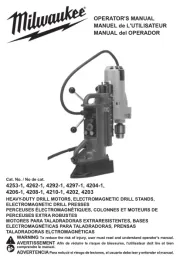
22 Juli 2025
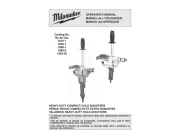
16 Juli 2025
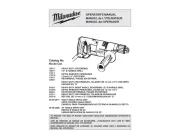
15 Juli 2025

15 Juli 2025
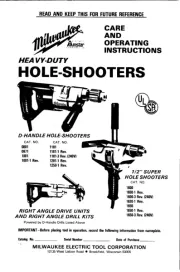
15 Juli 2025
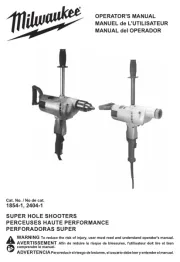
14 Juli 2025
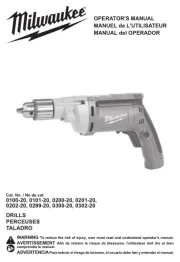
14 Juli 2025
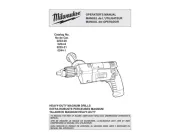
14 Juli 2025
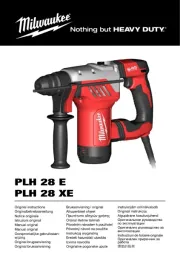
10 Juni 2025
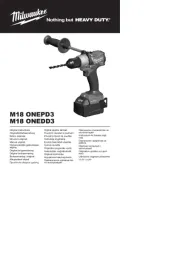
4 April 2025
Handleiding Boormachine
- Defort
- Meister Craft
- Proxxon
- DeWalt
- Tanaka
- Westfalia
- Blucave
- Basetech
- Ferm
- Rupes
- Stanley
- Max
- Rikon
- Cocraft
- Baumr-AG
Nieuwste handleidingen voor Boormachine
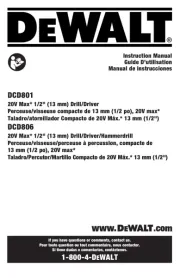
3 Augustus 2025
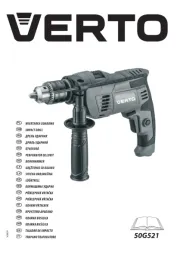
30 Juli 2025
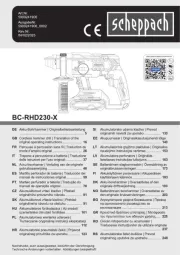
29 Juli 2025
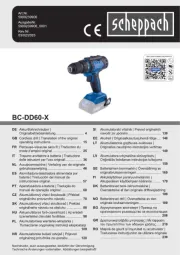
29 Juli 2025
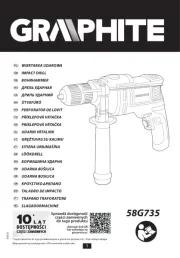
29 Juli 2025
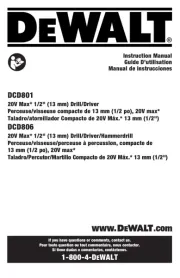
29 Juli 2025
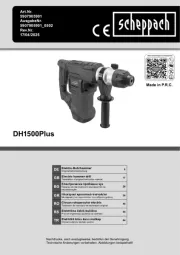
21 Juli 2025
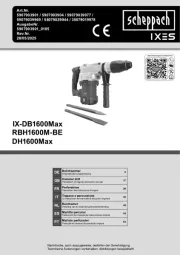
21 Juli 2025
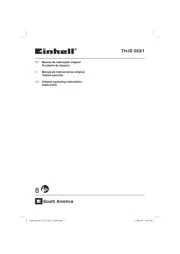
21 Juli 2025
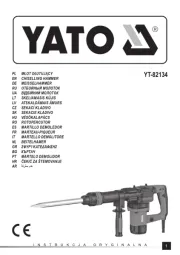
15 Juli 2025